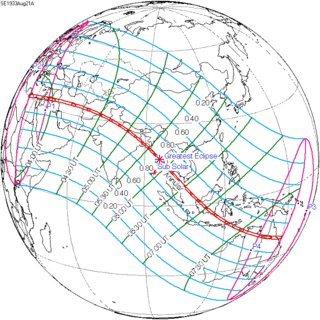| Solar eclipse of August 21, 1933 | |
|---|---|
| Type of eclipse | |
| Nature | Annular |
| Gamma | 0.0869 |
| Magnitude | 0.9801 |
| Maximum eclipse | |
| Duration | 124 s (2 min 4 s) |
| Coordinates | 16°54′N 95°54′E / 16.9°N 95.9°E |
| Max. width of band | 71 km (44 mi) |
| Times (UTC) | |
| Greatest eclipse | 5:49:11 |
| References | |
| Saros | 134 (39 of 71) |
| Catalog # (SE5000) | 9359 |
An annular solar eclipse occurred at the Moon's descending node of orbit on Monday, August 21, 1933,[1] with a magnitude of 0.9801. A solar eclipse occurs when the Moon passes between Earth and the Sun, thereby totally or partly obscuring the image of the Sun for a viewer on Earth. An annular solar eclipse occurs when the Moon's apparent diameter is smaller than the Sun's, blocking most of the Sun's light and causing the Sun to look like an annulus (ring). An annular eclipse appears as a partial eclipse over a region of the Earth thousands of kilometres wide. Occurring only 5.6 days after apogee (on August 15, 1933, at 15:40 UTC), the Moon's apparent diameter was smaller.[2]
Annularity was visible from Italian Libya (today's Libya), Egypt, Mandatory Palestine (today's Israel, Palestine and Jordan) including Jerusalem and Amman, French Mandate for Syria and the Lebanon (the part now belonging to Syria), Iraq including Baghdad, Persia, Afghanistan, British Raj (the parts now belonging to Pakistan, India, Bangladesh and Myanmar), Siam (name changed to Thailand later), Dutch East Indies (today's Indonesia), North Borneo (now belonging to Malaysia), and Australia. A partial eclipse was visible for parts of Northeast Africa, Eastern Europe, Asia, and Australia.
- ^ "August 21, 1933 Annular Solar Eclipse". timeanddate. Retrieved 3 August 2024.
- ^ "Moon Distances for London, United Kingdom, England". timeanddate. Retrieved 3 August 2024.
